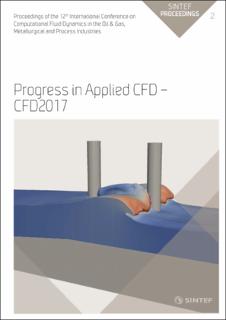| dc.contributor.author | Meese, Ernst A. | |
| dc.contributor.author | Johansen, Stein Tore | |
| dc.date.accessioned | 2020-12-21T08:23:28Z | |
| dc.date.available | 2020-12-21T08:23:28Z | |
| dc.date.created | 2018-01-27T15:10:41Z | |
| dc.date.issued | 2017 | |
| dc.identifier.citation | Progress in Applied CFD – CFD2017 Selected papers from 12th International Conference on Computational Fluid Dynamics in the Oil & Gas, Metallurgical and Process Industries | en_US |
| dc.identifier.isbn | 978-82-536-1544-8 | |
| dc.identifier.uri | https://hdl.handle.net/11250/2720463 | |
| dc.description.abstract | Simulation of multiphase flows is generally treated by various classes of Eulerian methods, Lagrangian methods, and various combinations of these. In the SIMCOFLOW initiative, we have set out to develop a framework for simulation of multi-material flows, using a Eulerian description. A fundamental part is the application of Cartesian grids with cut cells, and with a staggered representation of the grid for velocities and scalars. The model equations are derived based on formal volume and ensemble averaging (Quintard and Whitaker, 1995), (Gray and Lee, 1977) and (Cushman, 1982). Solid walls or moving solid materials are treated in the same manner as any flowing material (fluid, deforming material). The interface is characterized by a level set or by a 3D surface. In grid cells that are cut by a large-scale interface, the stress acting at the cut surface can be computed based on the level set or volume fractions. The exchange of mass, energy, and momentum between continuous fluids (note: walls are also considered a continuous fluid) can be estimated using wall functions in the case of coarse grids. The methods applied to the flow in a general geometry are closely related to the FAVOR method (Hirt and Sicilian, 1985) and the LS-STAG method (Cheny and Botella, 2010). In this paper, we discuss the derivation of the equations and the numerical solution strategy needed to handle such complex physics within the framework of finite volume methods. We further discuss briefly the ongoing developments such as adaptive gridding and the computational framework. The results of this work will end up as open source software. | en_US |
| dc.language.iso | eng | en_US |
| dc.publisher | SINTEF akademisk forlag | en_US |
| dc.relation.ispartof | Progress in Applied CFD – CFD2017 Selected papers from 12th International Conference on Computational Fluid Dynamics in the Oil & Gas, Metallurgical and Process Industries | |
| dc.relation.ispartofseries | SINTEF proceedings;2387-4295 | |
| dc.rights | Attribution-NonCommercial-NoDerivatives 4.0 Internasjonal | * |
| dc.rights.uri | http://creativecommons.org/licenses/by-nc-nd/4.0/deed.no | * |
| dc.subject | large scale interface | en_US |
| dc.subject | dispersed fields | en_US |
| dc.subject | volume averaging | en_US |
| dc.subject | staggered grid | en_US |
| dc.subject | Cartesian cut-cells | en_US |
| dc.subject | Multi-material flows | en_US |
| dc.title | A simulation concept for generic simulation of multi-material flow using staggered cartesian grids | en_US |
| dc.type | Chapter | en_US |
| dc.type | Peer reviewed | en_US |
| dc.description.version | publishedVersion | en_US |
| dc.rights.holder | SINTEF Proceedings er Open Access etter CC BY-NC-ND-lisensen (http://creativecommons.org/licenses/by-nc-nd/4.0/). | en_US |
| dc.source.pagenumber | 253-263 | en_US |
| dc.identifier.cristin | 1553406 | |
| cristin.unitcode | 7401,80,0,0 | |
| cristin.unitname | SINTEF Materialer og kjemi | |
| cristin.ispublished | true | |
| cristin.fulltext | original | |

